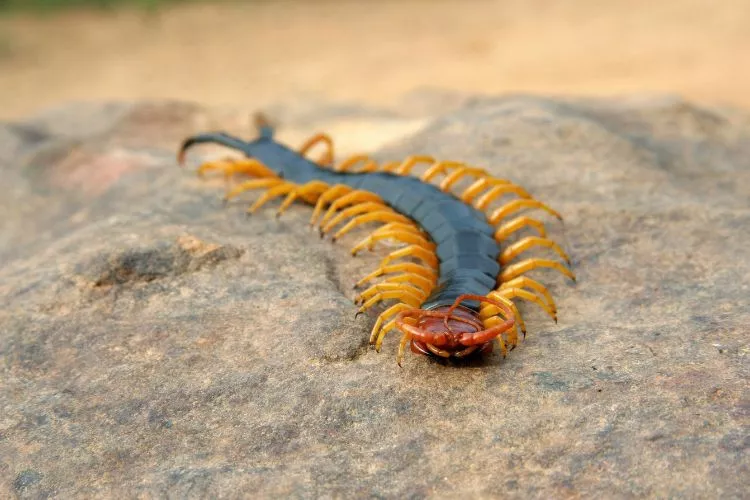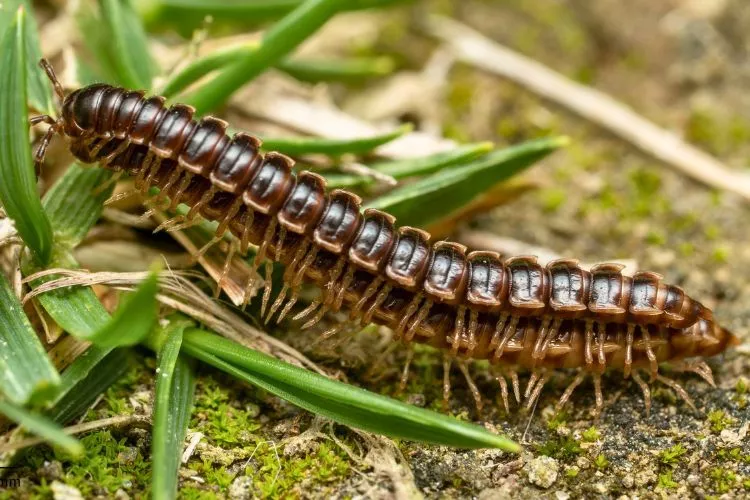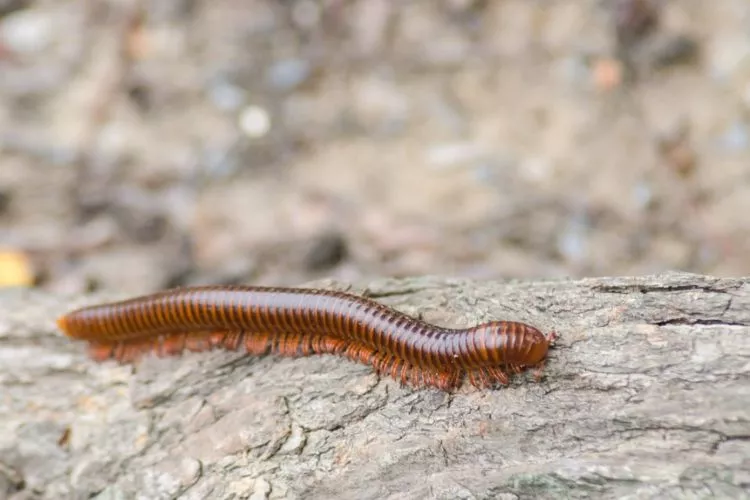Are you a feline owner whose cat has a curious, investigative nature? Then you would definitely relate to the constant vigilance required to keep our furry friends out of harm’s way.
Among the many concerns that pet-parents often encounter are potentially poisonous creatures that may be of concern. In this context, an intriguing question that presents itself is: are millipedes poisonous to cats?

This article aims to shed light on potential risks and precautions when your cat interacts with these many-legged critters.
Balancing easy-to-comprehend context with professional research, this article seeks to deliver a comprehensive understanding catered to all readers, from discerning pet owners to curious biology enthusiasts.
🐾 Are millipedes poisonous to cats?
Millipedes are generally not poisonous to cats. While millipedes can release foul-smelling fluids as a defense mechanism, the fluids are not toxic.
However, if a cat ingests a large number of millipedes, it’s possible the cat could experience some mild gastrointestinal upset like vomiting or diarrhea. This is because millipedes may carry bacteria, parasites or other pathogens that could infect the cat.
But a single millipede or occasional contact is highly unlikely to cause any issues. Cats may be tempted to play with or eat millipedes, so it’s best to keep them indoors and away from areas where millipedes congregate, like under porches, rocks or leaf litter.
Overall, the risks to cats from millipedes are very low as long as ingestion is avoided. But it’s always a good idea to contact your vet if your cat shows any signs of illness after encountering millipedes.
🐾 What bugs are poisonous to cats?
Cats can come across numerous bugs throughout their day, and while most are harmless, some can pose a risk to their health. Here are a few bugs to be aware of:

- Spiders: Certain species like the Black Widow, Brown Recluse, and Hobo Spider are extremely toxic to cats and can cause severe illness or even death.
- Scorpions: While all scorpions are venomous, not all species are dangerous to cats. However, the Bark Scorpion can cause serious harm.
- Bees and Wasps: Though not usually lethal, their stings can cause allergic reactions, including pain, swelling, and difficulty breathing.
- Centipedes and Millipedes: Some kinds of centipedes can sting and inject venom which can cause pain and minor swelling. While millipedes are generally harmless, some species release toxic compounds, though it’s typically not life-threatening.
- Fleas and Ticks: These small creatures are parasitic rather than poisonous, but still dangerous because they carry diseases that can compromise a cat’s health.
- Cockroaches, Ants, and Flies: While they’re not directly poisonous, they can carry various diseases and bacteria which can be harmful, especially if ingested by cats.
Remember, keeping your cats indoor and providing them with regular vet checks can help prevent most run-ins with harmful bugs. If you suspect your cat has interacted with a poisonous bug, promptly seek professional veterinary assistance.
🐾 What type of millipedes are poisonous?
Absolutely, below you’ll find the detailed information about the types of poisonous millipedes:

Several species of millipedes from different parts of the world are known to be poisonous:
- Spirobolida millipedes, including the giant desert millipede found in the southwestern United States, are one type. Their defensive secretions contain quinones which can cause skin irritation and inflammation in humans.
- Narceus americanus, also known as the garden millipede, is found mainly along the eastern seaboard of North America. These millipedes secrete hydrogen cyanide, a toxin, from their pores when threatened. This can be toxic to humans in large enough doses.
- Various species of Australasian millipedes, native to Australia and the surrounding regions, produce benzoquinone secretions. These secretions have been reported to cause dermatitis and respiratory issues in sensitive individuals. One species, the giant gray millipede, found in this region, is one of the largest poisonous species, growing over 8 inches long.
- Certain Amazonian millipedes, specifically tropical species in Central and South America, contain either benzoquinones or hydroquinones in their defensive secretions.
Always remember to handle all millipedes with care, or better yet, leave them untouched in their natural habitat to avoid any possible risks.
🐾 Are Portuguese millipedes poisonous to cats?
Portuguese millipedes, like other millipede species, are not inherently poisonous to cats if ingested. However, they carry a defensive mechanism that allows them to secrete various compounds when they feel threatened.

These secretions, comprising substances like hydrochloric acid, organic acids, phenol, cresols, hydrogen cyanide, benzoquinones, and hydroquinone, can cause skin irritation, burns, or discomfort in a cat’s digestive system.
Although not life-threatening in most cases, it may lead to symptoms like vomiting, diarrhea, excessive salivation, and muscle tremors.
Therefore, while not directly poisonous, Portuguese millipedes can still cause adverse effects on cats due to their defensive toxins.
🐾 How to get rid of millipedes?
This guide will provide you with step-by-step instructions to get rid of millipedes:
Step 1: Identify the Millipedes
Before you can get rid of millipedes, you need to confirm that millipedes are the pests you are dealing with. They are elongated arthropods, typically 1-2 inches long with many small legs. They tend to be passive and slow-movers.

Step 2: Understand Why They Are There
Millipedes usually invade your home or property because their current habitat becomes too dry. They are attracted to damp, dark places with abundant food sources, like decaying leaves and wood.
Step 3: Remove Their Food Source
Remove decaying wood, leaves, and compost piles on your property. Avoid excessive mulching and keep the best-ventilated areas as dry as possible.
Step 4: Proper home sealing and landscaping
Millipedes can crawl under doors and windows. Make sure you seal all the cracks and holes in your home. Use silicone-based caulk to seal up these areas.
Millipedes can be discouraged through proper landscaping. You can minimize plant life around the foundation of the house and not allow water to accumulate to create a less inviting environment for millipedes.
Step 5: Use Chemical Control
If a millipede infestation is large, it may be necessary to use pesticides. These chemical treatments include spraying pesticides, using insecticides, or applying diatomaceous earth or boric acid.
- Pesticides: Use a pesticide labeled for use against millipedes. Follow the application instructions on the packaging.
- Insecticides: Apply around the foundation of the house, other building structures, and potential entry points.
- Diatomaceous Earth: Use food-grade diatomaceous earth and spread it around areas where millipedes are found.
- Boric Acid: Apply boric acid powder to potential entry points.
All pesticides must be used with caution because they can be harmful to humans, pets, and the environment if misused.
Step 6: Seek Professional Pest Control
If your millipede problem is extensive, or if you’re unable to effectively treat it yourself, consider hiring a professional pest control service. These technicians have the appropriate equipment and knowledge to safely and effectively solve your millipede problem.

Remember, prevention is the best management strategy. By making your home and property less conducive to millipedes, you can avoid infestations in the future.
You may also like to find out: Can Cats Eat Raw Chicken?
Conclusion:
Millipedes are not classified as poisonous to cats, but certain types can excrete substances that might result in mild to moderate irritation in cats if they come into contact with them.
Due to their passive nature, millipedes aren’t usually a threat, and instances of cat illness due to millipedes are rare. Nonetheless, it’s advisable to prevent any interaction between cats and millipedes where possible to avoid any adverse reaction.
Always monitor your pet’s behavior, and consult with a vet immediately if you notice any changes following an encounter with a millipede.
